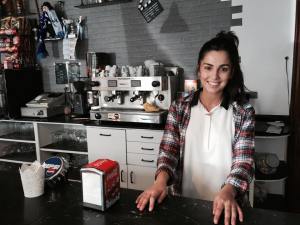
CORME-PORTO, Spain — The bad thing about being in Europe is not having ready access to Internet. Sure, that’s not exactly a problem, and if that is the toughest part of this trip, I will live with it.
It does mean that my blog posting will be sporadic, but let’s be honest, if I am cooped up in front of a computer instead of exploring this gorgeous countryside, then I am really missing the point of the whole experience.
I am here in Galicia to do an Artist-in-Residence with the Fundacion de Torre-Pulajes. I am staying for three weeks and I am supposed to produce a painting for the museum. It’s a tough job, but someone has to do it.

Corme-Porto is a village on the northwest coast of Spain, in the region of Galicia known as the Coste de Morte (the Coast of Death, but more of that another time). I knew it would be a small town and I was looking forward to a peaceful, gentle trip (Note: anyone who knows me knows that I am a city boy and I don’t do peaceful and gentle, but this was a chance to get away from it all and slow down).
The getting away from work and commitments is working, but the slowing down? Not a chance. This area is stunningly beautiful and there is so much to explore.
Despite 22 hours travel from Beaumont, the first night in Corme, my partner Ramona and I took off around the town for the evening. It stays light here until almost 11 p.m., due the fact that the area falls in Greenwich Mean Time, but keeps its time the same as the rest of Spain, which is one hour ahead.
Because of the light, or maybe just the excitement, one finds oneself in a restaurant at midnight, drinking wine without feeling tired and still waking up at 8 a.m. The tradition is for a mid-afternoon siesta, but who has time for that?
The first thing we discovered was that the food was exactly has we had been promised — magnifico! This region is famous for its seafood and it is easy to see why. Clams, lobster, prawn/lobster hybrids called lagostinos and croquettes filled with all manner of fish cover the menu.

But the most wonderful of all are the percebes —barnacles. These are a staple delicacy of the region and there is even a festival dedicated to the crustacean held every year in July. The percebes are dangerous to catch — a special license is required — prehistoric to look at, messy to open and stunningly tasty to eat. There is nothing fancy to them, no special sauces to cover the taste, no complicated grilling or curing process. Simply catch them, boil them, and chow down. They taste of the sea, slightly salty with a chewy consistency. Words cannot do them justice. The only way to appreciate them is to come on over to Galicia and try them yourself.
I always thought that I would never be a Facebook foodie — and honestly, I am not convinced that the hamburger from Chili’s is worth the status update — but I am turning into an amateur Anthony Bourdain. It is impossible to accurately document a cultural trip without acknowledging the culinary delights of the natives. So be warned. There is more food to come, as well as some history.

Now it’s off to the cafe where the waitress, Sabela, — who speaks no English — graciously smiles and encourages my bumbling Spanish, excitedly offering a “muy bien” when I get it anywhere close to being right. They have WiFi so maybe I can post this. Although, I haven’t had the crab yet….